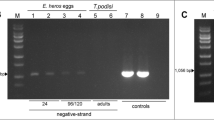Abstract
The relative activities of the granulovirus (PxGV) and the nucleopolyhedrovirus (PxMNPV) of the diamondback moth, Plutella xylostella (L.), against this insect were evaluated in the laboratory. Similar numbers of occlusion bodies (OBs) of PxGV and PxMNPV were required to kill P. xylostella. However, cadavers of insects infected with PxGV contained more OBs per unit weight than did cadavers infected with PxMNPV. Less cadaver material was thus required to kill insects with PxGV. Larvae that were killed by PxGV survived approximately 2 d longer than did those killed by PxMNPV. When P. xylostella larvae were fed both viruses together, mortality was higher than that caused by either virus alone. The virulence of PxMNPV produced in P.␣xylostella did not differ from that of PxMNPV produced in the beet armyworm, Spodoptera exigua (Hübner). S. exigua was less susceptible to PxMNPV than to its homologous nucleopolyhedrovirus, SeMNPV.
Similar content being viewed by others
Abbreviations
- AcMNPV:
-
Autographa californica multiple nucleopolyhedrovirus
- AfMNPV:
-
Anagrapha falcifera multiple nucleopolyhedrovirus
- ANOVA:
-
analysis of variance
- ARS:
-
Agricultural Research Service
- GmMNPV:
-
Galleria mellonella multiple nucleopolyhedrovirus
- GV:
-
granulovirus
- LD50 :
-
median lethal dose
- LSD:
-
least significant difference
- MNPV:
-
multiple nucleopolyhedrovirus
- OB:
-
occlusion body
- PxGV:
-
Plutella xylostella granulovirus
- PxMNPV:
-
Plutella xylostella multiple nucleopolyhedrovirus
- SeMNPV:
-
Spodoptera exigua multiple nucleopolyhedrovirus
- USDA:
-
United States Department of Agriculture.
References
Abdul Kadir H.B., Payne C.C., Crook N.E., Fenlon J.S., Winstanley D. (1999) The comparative susceptibility of the diamondback moth Plutella xylostella and some other major lepidopteran pests of brassica crops to a range of baculoviruses. Biocont Sci Technol 9:421–433
Asayama T. (1986) Pathology and morphogenesis of a granulovirus of the diamondback moth In: Griggs T.D. (ed.), Diamondback moth management: Proceedings of the first international workshop. 11–15 March, 1985 Asian Vegetable Research and Development Center, Shanhua, Taiwan pp205–212
Asayama T., Osaki N. (1970) A granulosis of the diamondback moth, Plutella xylostella. J Invertebr Pathol 15:284–286
Barrett J.W., Primavera M., Retnakaran A., Arif B., Palli S.R. (2002) Aspects of nucleopolyhedrovirus pathogenesis in lepidopteran larvae In: Koul O., Dhaliwal G.S. (eds.) Microbial biopesticides. Taylor & Francis, London pp205–214
Entwistle P.F., Evans H.F. (1985) Viral control In: Kerkut G.A., Gilbert L.I. (eds.) Comprehensive insect physiology, biochemistry and pharmacology. Pergamon Press, Oxford pp347–412
Farrar R.R. Jr., Ridgway R.L. (1998) Quantifying time-mortality relationships for nuclear polyhedrosis viruses when survivors are present. Environ Entomol 27:1289–1296
Farrar R.R. Jr., Ridgway R.L. (1999) Relative potency of selected nuclear polyhedrosis viruses against five species of Lepidoptera. J Agric Urban Entomol 16:187–196
Farrar R.R. Jr., Shapiro M., McIntosh A.H. (2004) Fluorescent brighteners can enhance or inhibit the nucleopolyhedrovirus of the diamondback moth (Lepidoptera: Plutellidae). J Entomol Sci 39:30–45
Federici B.A. (1986) Ultrastructure of baculoviruses In: Granados R.R., Federici B.A. (eds), The biology of baculoviruses, vol. 1, biological properties and molecular biology. CRC Press, Boca Raton, FL pp61–88
Gröner A. (1986) Specificity and safety of baculoviruses In: Granados R.R., Federici B.A. (eds), The biology of baculoviruses, vol. 1, biological properties and molecular biology. CRC Press, Boca Raton, FL pp177–202
Gröner A. (1990) Safety to nontarget invertebrates of baculoviruses In: Laird M., Lacey L.A., Davidson E.W. (eds), Safety of microbial insecticides. CRC Press, Boca Raton, FL pp135–147
Hunter-Fujita F.R., Entwistle P.F., Evans H.F., Crook N.E. (1998) Insect viruses and Pest Management Wiley, Chichester
Kariuki C.W., McIntosh A.H. (1999) Infectivity studies of a new baculovirus isolate for the control of diamondback moth (Plutellidae: Lepidoptera). J Econ Entomol 92:1093–1098
King E.G., Hartley G.G. (1985) Heliothis virescens In: Singh P., Moore R.F. (eds), Handbook of insect rearing, vol. II. Elsevier, New York. pp323–328
Payton M.E., Greenstone M.H., Schenker N. (2003) Overlapping confidence intervals or standard error intervals: What do they mean in terms of statistical significance? J Insect Sci 3:1–6
Robertson J.L., Preisler H.K. (1992) Pesticide Bioassays with Arthropods. CRC Press, Boca Raton, FL
SAS Institute, (1999) SAS Online Doc®. Version 8. Cary, NC
Sarfraz M., Keddie B.A. (2005) Conserving the efficacy of insecticides against Plutella xylostella (L.) (Lep., Plutellidae). J Appl Entomol 129:149–157
Sarfraz M., Keddie A.B., Dosdall L.M. (2005) Biological control of the diamondback moth, Plutella xylostella: a review. Biocontrol Sci Technol 15:763–789
Shapiro M. (1985) In vivo production of baculoviruses In: Granados R.R., Federici B.A. (eds), The Biology of baculoviruses, vol. I1, practical application for insect control. CRC Press, Boca Raton, FL pp31–61
Shelton A.M., Cooley R.J., Kroening M.K., Wilsey W.T., Eigenbrode S.D. (1991) Comparative analysis of two rearing procedures for diamondback moth (Lepidoptera: Plutellidae). J Entomol Sci 26:17–26
Talekar N.S., Shelton A.M. (1993) Biology, ecology and management of diamondback moth. Annu Rev Entomol 38: 275–301
Tanada Y. (1959) Synergism between two viruses of the armyworm, Pseudaletia unipuncta (Haworth) (Lepidoptera: Noctuidae). J. Insect. Pathol. 1:215–231
Tanada Y., Hukuhara T. (1971) Enhanced infection of a nuclear-polyhedrosis virus of the armyworm, Pseudaletia unipuncta, by a factor in the capsule of a granulosis virus. J. Invertebr. Pathol. 17:116–126
Tanada Y., Inoue H., Hess R.T., Omi E.M. (1980) Site of action of a synergistic factor of a granulosis virus of the armyworm, Pseudaletia unipuncta. J. Invertebr. Pathol. 34:249–255
Acknowledgements
We thank A. H. McIntosh (USDA-ARS, Columbia, MO, USA) for supplying the original sample of PxMNPV, L. J. Liska (USDA-ARS, Beltsville, MD, USA) for supplying P. xylostella larvae, R. Myers (USDA-ARS, Tifton, GA, USA) for supplying S. exigua eggs, C.␣Murphy (USDA-ARS, Beltsville, MD, USA) for electron microscopy of PxGV, and L. Lacey (USDA-ARS, Wapato, WA, USA) and D. Lynn (USDA-ARS, Beltsville, MD, USA) for comments on the manuscript.
Author information
Authors and Affiliations
Corresponding author
Additional information
Use of trade names does not imply endorsements by USDA-ARS of products named nor criticism of similar ones not mentioned.
Rights and permissions
About this article
Cite this article
Farrar, R.R., Shapiro, M. & Shepard, M. Relative activity of baculoviruses of the diamondback moth, Plutella xylostella (L.) (Lepidoptera: Plutellidae). BioControl 52, 657–667 (2007). https://doi.org/10.1007/s10526-006-9048-y
Received:
Accepted:
Published:
Issue Date:
DOI: https://doi.org/10.1007/s10526-006-9048-y




